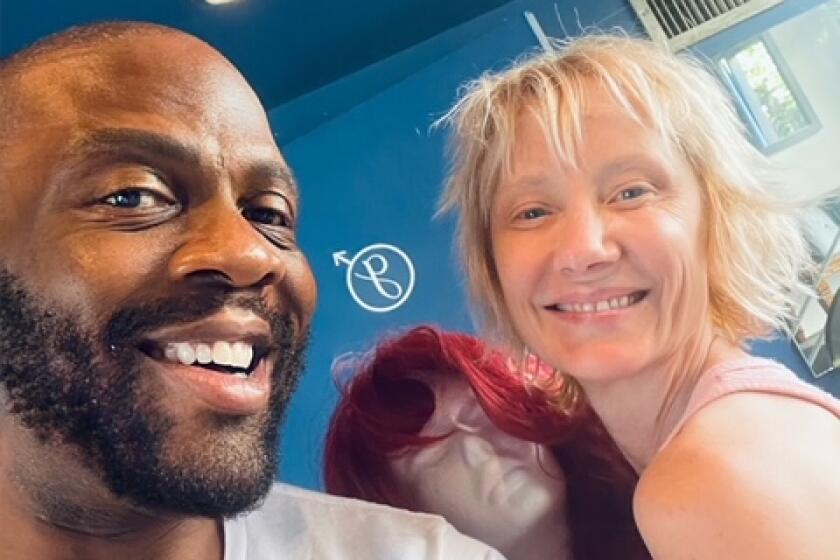When did Anne Heche die? Media are split in the definition of ‘dead’

Reports of Anne Heche’s death rolled out in waves — from Friday morning through Sunday evening, depending on the media outlet — prompting some in the news industry to reexamine their nuanced definition of the word “dead” and in some cases to reconsider policies on whether an obituary gets published while a subject remains on life support.
Heche smashed her Mini Cooper into an L.A. home Aug. 5 and was severely burned when the car erupted in flames. Fifty-nine firefighters spent more than an hour trying to extinguish the blaze, and Heche was taken to the hospital in critical condition.
Around 11 a.m. Friday, TMZ became the first major outlet to report that Heche had died. In its obituary, the gossip site attributed her death to her representative. “Her rep tells TMZ Anne is ‘brain dead’ and under California law that is the definition of death,” the site said.
In California a person is indeed considered legally dead when either their heart or brain ceases to function. Life support machinery can keep the heart beating and the lungs going, however, as was the case with Heche, who had wanted to be an organ donor.
A half-hour before crashing into a Mar Vista home, Anne Heche stopped by a Venice hair salon to buy a bright red wig — because the blue one was taken.
Most major news organizations, including the Los Angeles Times, historically have waited to declare a person “dead” and to publish the obituary only after life support has been disconnected. In Heche’s case, however, the media response showed signs of a growing divide in approaches.
Shortly after the TMZ posting, People magazine posted that “Emmy Award-winning actress Anne Heche has died,” clarifying later in the article: “The family’s rep confirms to People that, while Heche is legally dead according to California law, her heart is still beating and she has not been taken off life support in order to allow OneLegacy Foundation enough time to find recipients who will be a match.”
While the Guardian and other media outlets published headlines announcing that Heche had died, the L.A. Times initially held off declaring her “dead.” The Times reported that Heche was brain dead but remained on life support so that her organs could be donated. The Times chose to wait to publish an obituary until later Friday, after the family released a statement saying that Heche had died; Times reporters reached Heche’s eldest son, Homer Laffoon, who said his mother had died, at which point the obituary published.
The New York Times published its obituary on Sunday, after Heche had been taken off life support. The Washington Post sent out a push alert about Heche’s death on Sunday night.
“We reported on the news developments as they happened, but out of respect for the family, we held off on publishing a formal obituary until her death was officially confirmed,” a spokesperson for the New York Times said Monday by email.
That news organizations across the globe unfurled reports of Heche’s death in a hodge-podge fashion throughout the weekend proved disconcerting but was not without precedent.
After rock musician Tom Petty suffered cardiac arrest at his Malibu home in 2017, public confusion reigned over whether he was dead or alive. EMTs who rushed to Petty’s home in the wee hours of an October morning were able to get a pulse, and the musician was put on life support when he arrived at UCLA Medical Center.
However, Petty couldn’t be revived. According to TMZ, he had no brain activity upon arrival at the hospital. Petty “died peacefully,” according to a statement issued by his family, at 8:40 p.m. Monday night — but not before various media outlets, including Rolling Stone and Variety, had declared him dead during the day and then retracted or updated their reports. For hours, the “American Girl” singer was either dead, hospitalized, “clinging to life” or “fighting for his life,” depending on the publication.
In the case of Natasha Richardson, who died in March 2009 after hitting her head in a fall on the ski slopes in Quebec, the actor was kept alive for two days after she was declared brain dead. On direction from husband Liam Neeson, Richardson was flown from Quebec back home to New York, admitted to a hospital and ultimately removed from life support once her loved ones were able to gather around her.
Richardson’s heart, kidneys and liver went to other people. “She’s keeping three people alive at the moment. ... It’s terrific and I think she would be very thrilled and pleased by that,” Neeson told CNN in 2014.
“We have a lot of powers as journalists, but life and death is not one of them,” says Ari L. Goldman, a professor at Columbia Journalism School who teaches a course called “The journalism of death and dying.” “I think we have to wait for the end of life, and for the withdrawal of life support.”
Otherwise, Goldman says, too much power is placed in the hands of news organizations, which might be inclined to race toward a conclusion that may not yet come to pass.
“I’m very much from the school of getting it right, not getting it first,” Goldman says. “And I think this is one of those situations where you have to get it right.”
Plus, an obituary should not become about a person’s death, or how they died, Goldman adds. It should be about their life — how they lived it and what they accomplished.
More to Read
The biggest entertainment stories
Get our big stories about Hollywood, film, television, music, arts, culture and more right in your inbox as soon as they publish.
You may occasionally receive promotional content from the Los Angeles Times.













